Key Differences Between Blood and Urine Tests
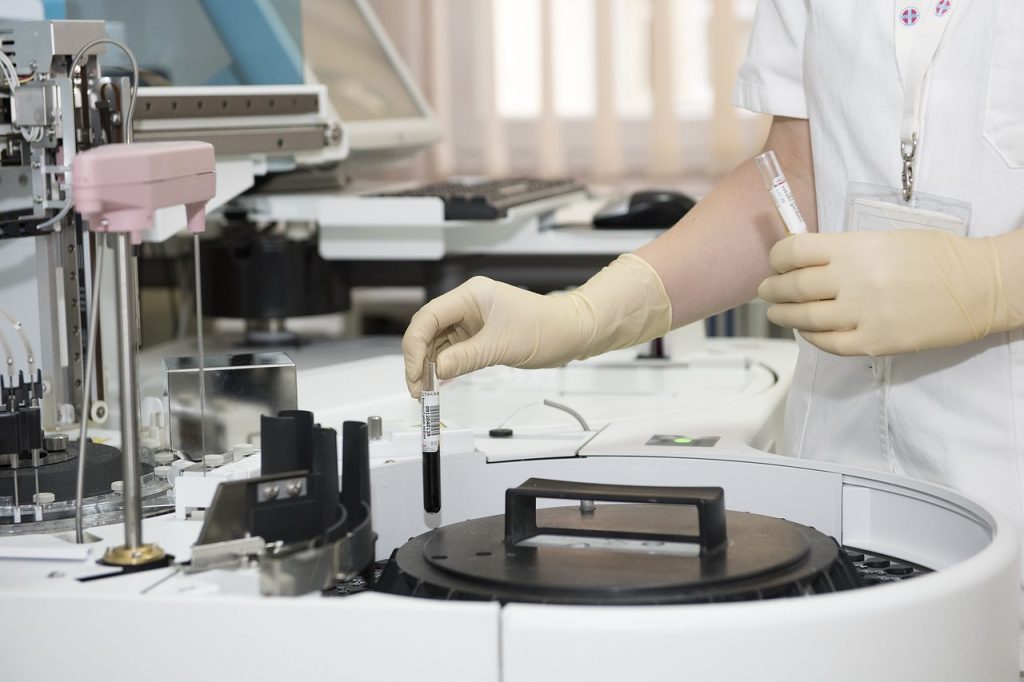
Understanding Blood and Urine Drug Tests
Drug tests plays a crucial role in various industries, legal situations, and healthcare settings. Two of the most common types of drug tests are blood and urine drug tests. These tests help detect the presence of illegal substances or prescription drugs in an individual’s system. In this section, we’ll define both types of tests, explore how they work, and highlight the differences between them.
What is a Blood Drug Test?
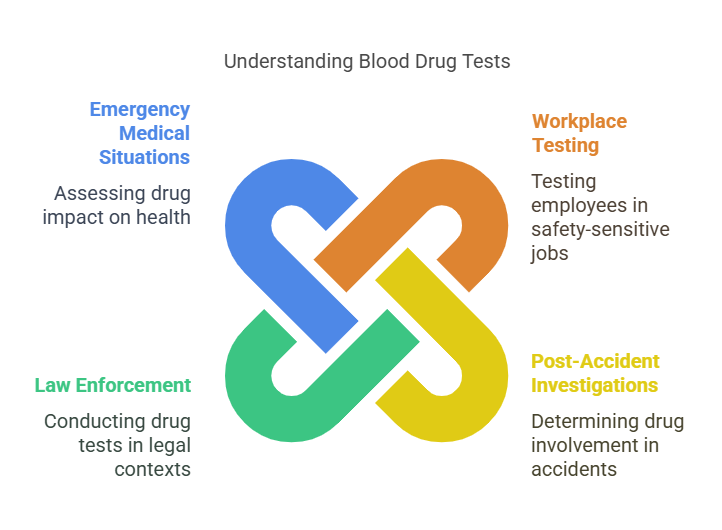
A blood drug test involves drawing a sample of blood from an individual to test for the presence of drugs or their metabolites. This type of test is typically conducted in a medical or clinical setting and is considered one of the most accurate methods for detecting recent drug use. It provides a snapshot of the drugs that are actively circulating in the bloodstream.
Blood drug tests are usually conducted for legal or medical purposes, such as:
- Workplace testing for employees in safety-sensitive positions
- Post-accident investigations to determine if drugs were involved
- Law enforcement scenarios (e.g., DUI testing)
- Emergency medical situations to assess the impact of drugs on a patient’s health
The blood sample is analyzed in a lab to detect specific substances, such as marijuana, cocaine, opiates, or methamphetamines. Blood drug tests are highly effective at identifying drugs used recently, typically within the past few hours to a few days.
What is a Urine Drug Test?
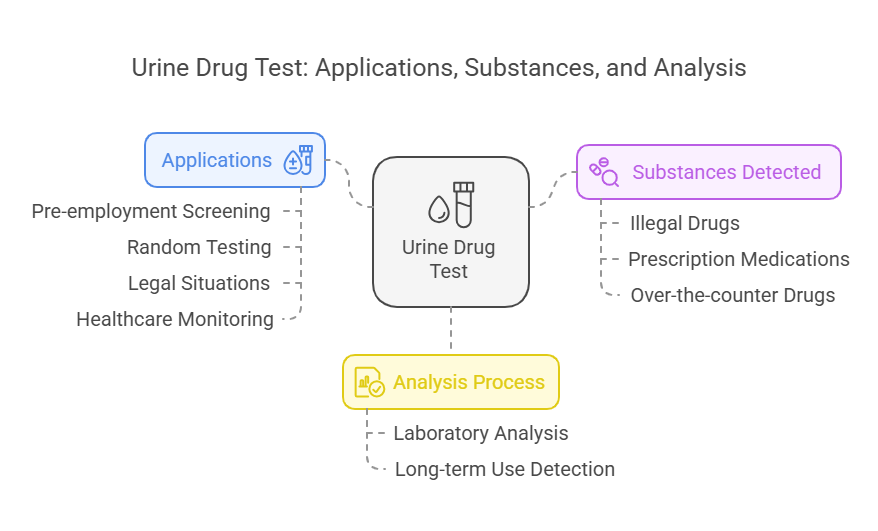
A urine drug test is a non-invasive procedure where an individual provides a urine sample that is tested for the presence of drugs or their metabolites. This type of test is one of the most commonly used for pre-employment screening, random testing, and legal situations. It is also frequently used in healthcare settings, such as when monitoring patients who are prescribed medication.
Urine drug tests are typically used to detect:
- Illegal drugs (e.g., marijuana, cocaine, heroin)
- Prescription medications (e.g., opioids, benzodiazepines)
- Over-the-counter drugs (e.g., certain antihistamines)
The sample is analyzed in a laboratory, where it is tested for a range of drugs or metabolites. Urine drug tests are widely favored because they are inexpensive, easy to administer, and provide reliable results for long-term drug use (in some cases up to several days or weeks after use).
How Blood and Urine Drug Tests Work
- Blood Drug Test: Blood drug tests work by detecting the presence of drugs or their metabolites in the bloodstream. When drugs are ingested or consumed, they enter the bloodstream and are metabolized by the liver before being eliminated through various pathways, including the urine. Because the test detects drugs circulating in the bloodstream, it is most effective at identifying recent drug use.
- Urine Drug Test: Urine drug tests work by detecting the presence of drugs or metabolites in the urine. Drugs are filtered out of the blood by the kidneys and excreted in the urine. While a urine test does not detect the immediate presence of drugs, it is useful for identifying drugs that have been used in the past few days or weeks.
Comparison: Blood Drug Test vs Urine Drug Test
To better understand the differences between blood and urine drug tests, let’s take a closer look at their respective advantages and disadvantages:
| Factor | Blood Drug Test | Urine Drug Test |
|---|---|---|
| Detection Window | Typically detects drugs within a few hours to 3 days | Detects drug use within the past 1 to 30 days, depending on the drug |
| Accuracy | Highly accurate for recent drug use | Generally accurate but may have false positives or negatives |
| Invasiveness | Invasive (requires needle for blood draw) | Non-invasive (requires urine sample) |
| Comfort Level | Less comfortable due to needle insertion | More comfortable and easier to perform |
| Cost | More expensive and time-consuming | More affordable and quicker to administer |
| Common Uses | Legal situations, medical emergencies, post-accident testing | Pre-employment screening, random drug tests, routine monitoring |
| Detection of Alcohol | Can detect alcohol levels | Cannot detect alcohol levels effectively |
| Detection of Recent Use | Best for detecting recent use of drugs | Can detect long-term drug use |
Which Drugs Do Blood and Urine Tests Detect?
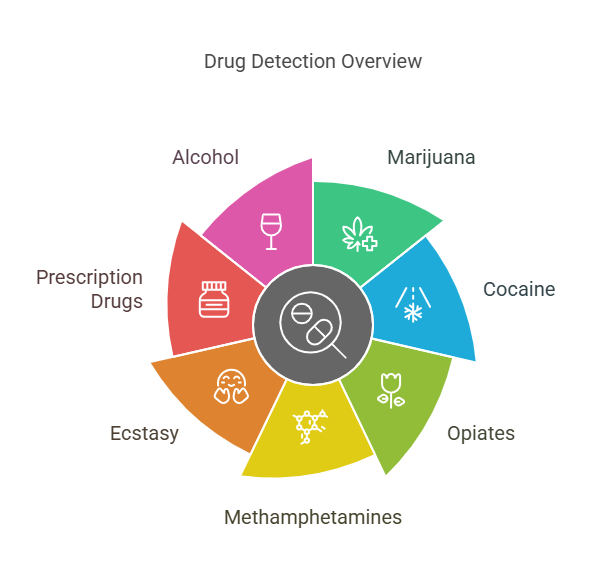
Both blood and urine tests can detect a variety of drugs, but the types of drugs and the detection windows differ for each type of test:
Drugs Commonly Tested in a Blood Drug Test:
- Marijuana (THC)
- Cocaine and its metabolites
- Opiates (heroin, morphine, codeine)
- Methamphetamines
- Ecstasy (MDMA)
- Prescription drugs (e.g., benzodiazepines, opiates)
- Alcohol
Blood drug tests are often used to detect immediate drug use, typically within the last few hours. It is most commonly used in legal or emergency medical settings.
Drugs Commonly Tested in a Urine Drug Test:
- Marijuana (THC)
- Cocaine and its metabolites
- Opiates (heroin, morphine, oxycodone)
- Methamphetamines
- Benzodiazepines
- Alcohol (in some cases)
- Phencyclidine (PCP)
- Nicotine and cotinine
Urine tests are typically used to detect long-term drug use, and the detection window can vary depending on the frequency of use, the drug in question, and an individual’s metabolism.
Common Scenarios for Blood and Urine Drug Tests
Blood Drug Test Scenarios:
- Workplace Testing: Blood tests may be used for post-accident testing or when an employee is suspected of being under the influence at work.
- Legal and Law Enforcement: Blood tests are commonly used in DUI or DWI cases to assess blood alcohol content or to detect recent drug use.
- Healthcare Settings: Blood tests may be used in medical situations, such as when doctors suspect recent drug use and need to quickly assess a patient’s condition.
Urine Drug Test Scenarios:
- Pre-Employment Screening: Urine tests are commonly used as part of the hiring process to ensure that potential employees are drug-free.
- Random Testing: Many employers use urine drug tests as part of a random testing policy to ensure a drug-free workplace.
- Monitoring Prescription Use: In some healthcare situations, urine tests are used to monitor patients who are prescribed drugs such as opioids to ensure compliance.
Blood Drug Test vs Urine Drug Test: Comparison and Best Practices
We explored the fundamental differences between blood and urine drug tests, including what substances each test can detect, how they work, and typical scenarios in which they are used. In this section, we will dive deeper into the comparison between these two types of drug tests and discuss best practices to ensure accurate results.
1. Detection Window: How Far Back Can Each Test Detect Drug Use?
One of the most significant differences between blood and urine drug tests is the detection window—the period during which a test can detect the presence of drugs in the body. The detection window depends on several factors, including the type of drug, how often it is used, and the individual’s metabolism.
Blood Drug Test Detection Window:
Blood drug tests are typically used to detect recent drug use. Since drugs are actively circulating in the bloodstream, they can usually be detected within a short window of time—usually within the last few hours to a couple of days after consumption. The detection window depends on the substance:
- Marijuana (THC): Detectable within 1-3 days of use.
- Cocaine: Detectable within 12-48 hours of use.
- Methamphetamines: Detectable within 1-3 days of use.
- Opiates: Detectable within 1-2 days of use.
- Alcohol: Detectable within 6-12 hours of consumption.
In summary, blood tests are best suited for detecting recent drug use and are not effective for identifying long-term substance use.
Urine Drug Test Detection Window:
Urine drug tests have a longer detection window compared to blood tests. The metabolites of drugs are excreted in urine over time, which means they can be detected for a longer period after consumption. For most drugs, the detection window in urine is typically between 3 to 30 days, depending on usage patterns:
- Marijuana (THC): Detectable for 3-30 days, depending on frequency of use.
- Cocaine: Detectable for 2-4 days after use.
- Methamphetamines: Detectable for 3-5 days after use.
- Opiates: Detectable for 2-4 days after use.
- Alcohol: Typically not detected in urine after 12-24 hours, though specific tests may detect metabolites for longer.
For occasional users, urine tests may detect drugs for a few days, while chronic users may have detectable levels for several weeks after use. Urine drug tests are preferred when employers or institutions want to assess long-term drug use.
2. Accuracy: Which Test is More Accurate?
Both blood and urine drug tests are considered reliable, but there are some important differences in terms of accuracy.
Blood Drug Test Accuracy:
Blood tests are often regarded as the most accurate form of drug testing for detecting recent use. This is because blood samples are directly tested for the presence of drugs or their metabolites in the bloodstream. Blood tests are less susceptible to errors caused by false positives or false negatives when compared to urine tests, especially when it comes to detecting recent use.
However, false negatives can still occur if an individual has consumed the drug right before the test or if the detection window has already passed. Additionally, invasive procedures (requiring blood draws) can sometimes lead to issues such as contamination or improper sample handling.
Urine Drug Test Accuracy:
Urine drug tests are generally accurate for detecting drugs, but they are more prone to errors when it comes to false positives and false negatives. False positives can occur due to certain medications or foods, while false negatives may happen if the sample is diluted by excessive hydration.
Urine tests are also more vulnerable to tampering, as individuals may attempt to dilute, substitute, or adulterate their urine sample to pass the test. While this is less common in professionally managed testing, it remains a concern for at-home testing or less supervised environments.
Despite these issues, urine tests are often regarded as a highly reliable option for routine and long-term drug use detection.
3. Invasiveness: How Comfortable Is Each Test?
Invasiveness is another important factor to consider when choosing between blood and urine drug tests.
Blood Drug Test Invasiveness:
Blood drug tests are considered invasive because they require a needle to draw blood. While many individuals are familiar with blood draws from routine medical tests, some people may find this process uncomfortable or anxiety-inducing. Blood tests are typically conducted in medical settings such as hospitals or specialized clinics.
Blood tests also require trained professionals to collect and handle the sample properly, which can lead to increased costs and time. This makes blood tests less convenient for some workplaces or random testing situations.
Urine Drug Test Invasiveness:
Urine drug tests are non-invasive and far less discomforting. The individual simply provides a urine sample, which is then analyzed in a lab. There are no needles or medical procedures involved, making this a preferred choice for many workplaces.
Because urine drug tests are less invasive, they can be more easily administered in workplaces or other settings where a high volume of tests is needed. They are also generally less expensive and quicker to conduct than blood tests.
4. Factors That Can Influence the Results of Both Tests
Several factors can influence the results of both blood and urine drug tests. It is important to understand these influences to ensure accurate results and avoid potential complications.
Factors Affecting Blood Drug Tests:
- Hydration Level: Hydration does not significantly affect blood tests as it does with urine tests.
- Metabolism: Individuals with a faster metabolism may eliminate drugs more quickly, potentially resulting in a negative result even if the drug was recently used.
- Recent Use: Drugs in the bloodstream are most likely to be detected immediately after use. However, chronic users may have elevated levels in their blood for a longer period.
Factors Affecting Urine Drug Tests:
- Hydration Level: Over-hydration or dilution of urine can result in a false negative. Individuals may attempt to dilute their urine to pass a drug test.
- Frequency of Use: Frequent drug use leads to higher concentrations of metabolites in the urine, increasing the detection window.
- Metabolism: Similar to blood tests, an individual’s metabolism will play a significant role in how long drugs stay in the urine.
- Adulterants: Urine samples are more vulnerable to adulteration (e.g., using chemicals to change the test results), which can lead to inaccurate results.
5. Best Practices for Employers and Employees
For Employers:
- Select the Right Test: Blood tests are ideal for detecting recent use, while urine tests are better for long-term use. Choose the test based on the drug use you need to detect.
- Create Clear Policies: Employers should establish clear drug testing policies that include the types of tests (blood, urine) and the substances being tested.
- Ensure Compliance: Make sure all drug testing procedures are compliant with federal, state, and local laws.
- Offer Support: Provide resources or support for employees who test positive, ensuring that any necessary interventions or treatment programs are available.
For Employees:
- Know Your Rights: Understand the legal requirements and your rights under federal and state laws regarding drug testing.
- Prepare for Testing: Be aware of the type of test you may be asked to take and the substances that will be tested.
- Stay Honest: If you are unsure whether a substance will show up on a test, it is better to be upfront with your employer or the testing agency.
Legal Aspects of Blood and Urine Drug Testing
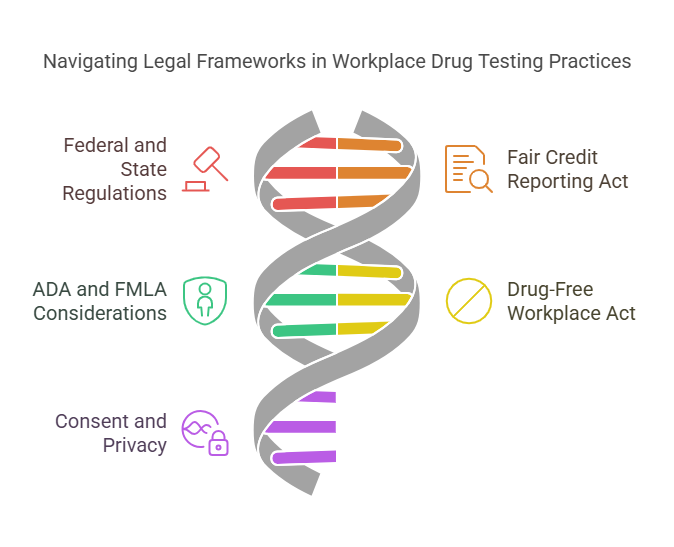
Drug testing in the workplace is subject to a variety of legal guidelines and regulations. Employers must be mindful of these laws to ensure that their drug testing policies and practices are compliant. Here are some key legal considerations:
1. Federal and State Regulations:
Drug testing is governed by both federal and state laws. Federal agencies, such as the Department of Transportation (DOT), have strict guidelines on drug testing for certain safety-sensitive industries like transportation. Similarly, employers in safety-sensitive positions (e.g., aviation, public transportation) are required to comply with federal drug testing regulations.
At the state level, laws regarding drug testing vary. Some states have more restrictive laws, especially regarding marijuana testing due to its legal status in several states. Employers should be aware of both federal and state regulations to avoid legal challenges.
2. Fair Credit Reporting Act (FCRA):
The Fair Credit Reporting Act (FCRA) governs how employers can conduct background checks, including drug testing. Employers must:
- Obtain consent from the employee before conducting a drug test.
- Disclose the testing procedure clearly in advance, especially in the context of background checks.
- Adhere to confidentiality regulations regarding the results of drug tests.
The FCRA also requires that employers provide an adverse action notice if a drug test result leads to negative consequences, such as job termination or failure to hire.
3. Americans with Disabilities Act (ADA) and Family and Medical Leave Act (FMLA):
Both the ADA and FMLA protect employees from discrimination based on health conditions and leave entitlements, but they do not provide specific protections for individuals who test positive on drug tests.
- The ADA prohibits discrimination against individuals with disabilities but does not protect employees who use drugs illegally or are currently using drugs.
- The FMLA entitles employees to take medical leave for certain health conditions, but it does not require employers to waive drug testing policies.
Employers should ensure that drug testing is not used to discriminate against individuals with medical conditions protected by the ADA or FMLA.
4. Drug-Free Workplace Act:
For employers seeking to maintain a drug-free workplace, the Drug-Free Workplace Act (DFWA) requires federal contractors and grantees to implement policies that prohibit the use of illegal drugs in the workplace and to enforce testing for employees. Employers subject to this act must adhere to its provisions and ensure that their drug testing policies are consistent with federal guidelines.
5. Consent and Privacy Considerations:
Drug testing policies must always be voluntary and conducted with informed consent. Employees must be fully aware of their rights and obligations regarding drug testing, and they should be informed about:
- What substances are being tested.
- How the test will be administered.
- The potential consequences of a positive test result.
Additionally, employers must ensure that any personal information, including drug test results, is kept confidential and handled according to privacy regulations.
FAQs About Blood and Urine Drug Tests
Now, let’s answer some common questions employees and employers often have about blood and urine drug tests:
What is the difference between a blood drug test and a urine drug test?
A blood drug test measures the presence of drugs or metabolites in the bloodstream, making it ideal for detecting recent drug use. It is more accurate but invasive and typically has a shorter detection window (a few hours to a couple of days).
How long does it take to get the results from a blood or urine drug test?
- Blood tests typically provide results within hours to a couple of days, depending on the testing method.
- Urine tests usually take 1-3 days for results, depending on the laboratory and the complexity of the analysis.
Some employers may offer rapid testing for both blood and urine, where results are available within minutes or hours, but this is less common.
Which drug test is more accurate for detecting recent drug use?
A blood drug test is generally considered the most accurate for detecting recent drug use, as it measures the drugs still circulating in the bloodstream. However, the accuracy of both tests depends on factors such as drug type, amount used, and the timing of the test.
Can a blood drug test detect drugs that a urine test might miss?
Blood tests are generally more sensitive to detecting drugs in the immediate period after use (hours to days). However, urine tests can sometimes detect metabolites that a blood test might miss, particularly if the drug was used earlier but still remains in the system. Urine tests are better for detecting long-term use and can provide a broader view of drug consumption over time.
Are there any legal implications of failing a blood or urine drug test in the workplace?
Yes, failing a drug test in the workplace can have legal consequences. Depending on the employer’s drug testing policies, an employee may face disciplinary actions or even termination. Legal implications may also arise if the drug test results are used in violation of laws such as the Americans with Disabilities Act (ADA) or the Family and Medical Leave Act (FMLA).
Employers must ensure that their drug testing policies are legally compliant, and they must respect employee privacy rights while taking appropriate actions based on the results.
What is the difference between a blood drug test and a urine drug test?
A blood drug test measures the presence of drugs or metabolites in the bloodstream, making it ideal for detecting recent drug use. It is more accurate but invasive and typically has a shorter detection window (a few hours to a couple of days).
How long does it take to get the results from a blood or urine drug test?
- Blood tests typically provide results within hours to a couple of days, depending on the testing method.
- Urine tests usually take 1-3 days for results, depending on the laboratory and the complexity of the analysis.
Some employers may offer rapid testing for both blood and urine, where results are available within minutes or hours, but this is less common.
Which drug test is more accurate for detecting recent drug use?
A blood drug test is generally considered the most accurate for detecting recent drug use, as it measures the drugs still circulating in the bloodstream. However, the accuracy of both tests depends on factors such as drug type, amount used, and the timing of the test.
Can a blood drug test detect drugs that a urine test might miss?
Blood tests are generally more sensitive to detecting drugs in the immediate period after use (hours to days). However, urine tests can sometimes detect metabolites that a blood test might miss, particularly if the drug was used earlier but still remains in the system. Urine tests are better for detecting long-term use and can provide a broader view of drug consumption over time.
Are there any legal implications of failing a blood or urine drug test in the workplace?
Yes, failing a drug test in the workplace can have legal consequences. Depending on the employer’s drug testing policies, an employee may face disciplinary actions or even termination. Legal implications may also arise if the drug test results are used in violation of laws such as the Americans with Disabilities Act (ADA) or the Family and Medical Leave Act (FMLA).
Employers must ensure that their drug testing policies are legally compliant, and they must respect employee privacy rights while taking appropriate actions based on the results.
Conclusion
In this article, we’ve compared blood drug tests and urine drug tests, exploring the differences in detection windows, accuracy, invasiveness, and legal implications. Both tests have their pros and cons depending on the situation, and selecting the right test for your needs is essential for accurate results.
For employers, it’s important to create clear and compliant drug testing policies that respect employee rights while maintaining a safe and drug-free workplace. For employees, understanding your rights, the testing process, and the potential outcomes of drug testing is crucial.
Partnering with a trusted professional service like Precise Hire can help ensure that drug testing is conducted fairly, legally, and accurately, with a focus on compliance and transparency for both employers and employees.
